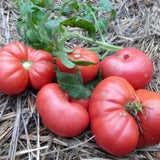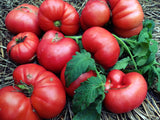Aunt Lou's Underground Railroad Tomato
Solanum lycopersicum
Storied, dark pink-red slicer weighing in at 4-12 ounces with a pleasant tang and lots of seeds. While tomatoes are native to South America and were likely domesticated in Mexico, the story of this particular variety begins in the mid-19th century with an unnamed Black man, perhaps escaping slavery, from Kentucky to Ripley, Ohio, seeds in hand. Ripley was home to Rankin House, which is now known to have been an important safe house on the underground railroad, and it was in this town where he shared some of these tomato seeds with a white woman named Lou. Aunt Lou shared this tomato with her great nephew Francis Parker, who was quite a character, and who shared seed packets with hand-written descriptions far and wide. Parker shared the seeds with a Mr. Ellis in Sardinia, Ohio, who passed them to tomato enthusiasts Gary Millwood of Kentucky's Blue Ribbon Tomatoes and seed keeper Mary Stenger in Berea, KY. They consulted with Mr. Ellis about the story, and decided to change the name from simply “Aunt Lou” to the name it has today. In 2010, Stenger listed this tomato in the Seed Savers Exchange Yearbook, and in 2018, Jay Erisman’s nomination earned the tomato a place in the Slow Food Ark of Taste.
Photo credit: Southern Exposure Seed Exchange.
Days to maturity: 70-80
Seeds per pack: 25
Germination rate: 97% on 05/16/2025
Planting / harvesting notes
Start seeds 6-8 weeks before the last frost and transplant into garden well after the danger of frost. We recommend you prune the suckers that form in the crotches of the branches by the main stem. Water tomatoes at the soil level, keeping the leaves dry. Stake tomatoes so that their leaves and branches are kept off the ground, for good airflow between plants, and for easier harvest.
Seed keeping notes
Tomatoes are generally self-pollinating, though we isolate different varieties by 35-50 feet, in hopes that flying insects will not cross pollinate them unexpectedly. Tomato seeds are ripe when the fruits are ready to eat! Cut the fruit at the equator and squeeze or scrape out seeds from each of the cavities. In a cup or bucket, add a little water (1/2" is probably plenty) to your seeds and pulp to keep them from drying out, and allow them to ferment away from direct sunlight. Ideally, you will stir the concoction every day for 3-5 days. In the end, add more water to fill the vessel, stir one final time, and allow to settle. Pour off the floating material and then strain the seeds through a strainer. Sometimes, you will need to add more water and pour off the floating material several times until the water is clear and you can see the seeds sunken at the bottom. Squeeze dry the strained seeds in a towel, and then lay out to dry on a labeled screen or paper product in a ventilated place away from direct sunlight for a week or two.









